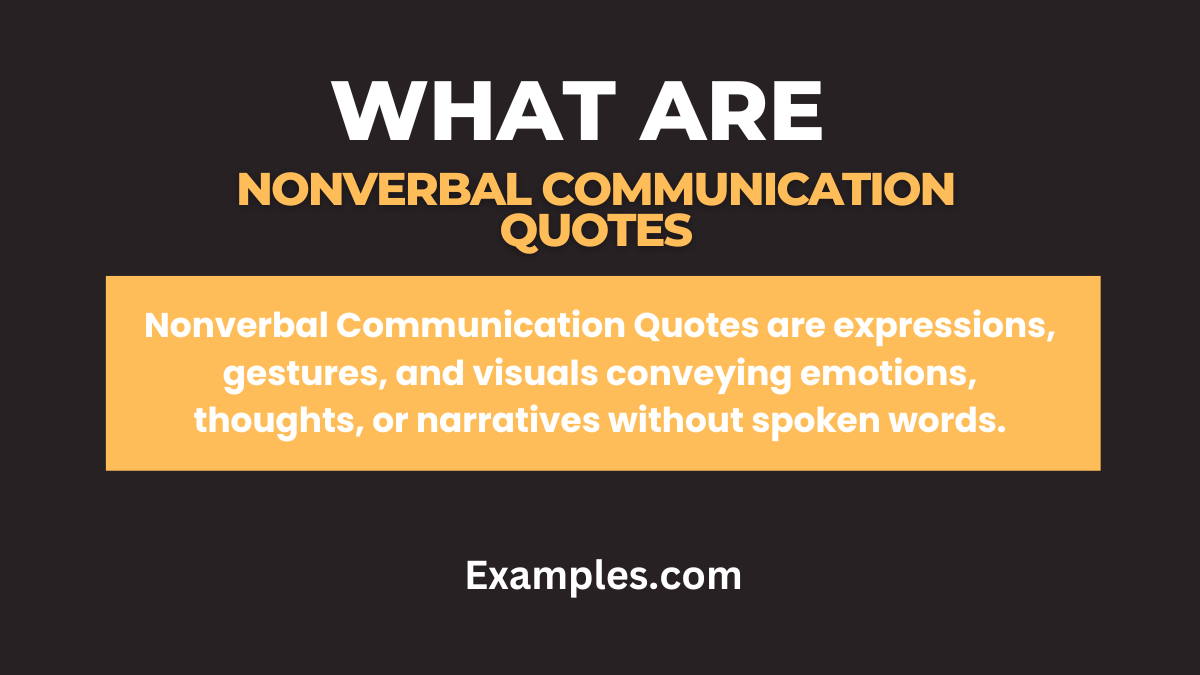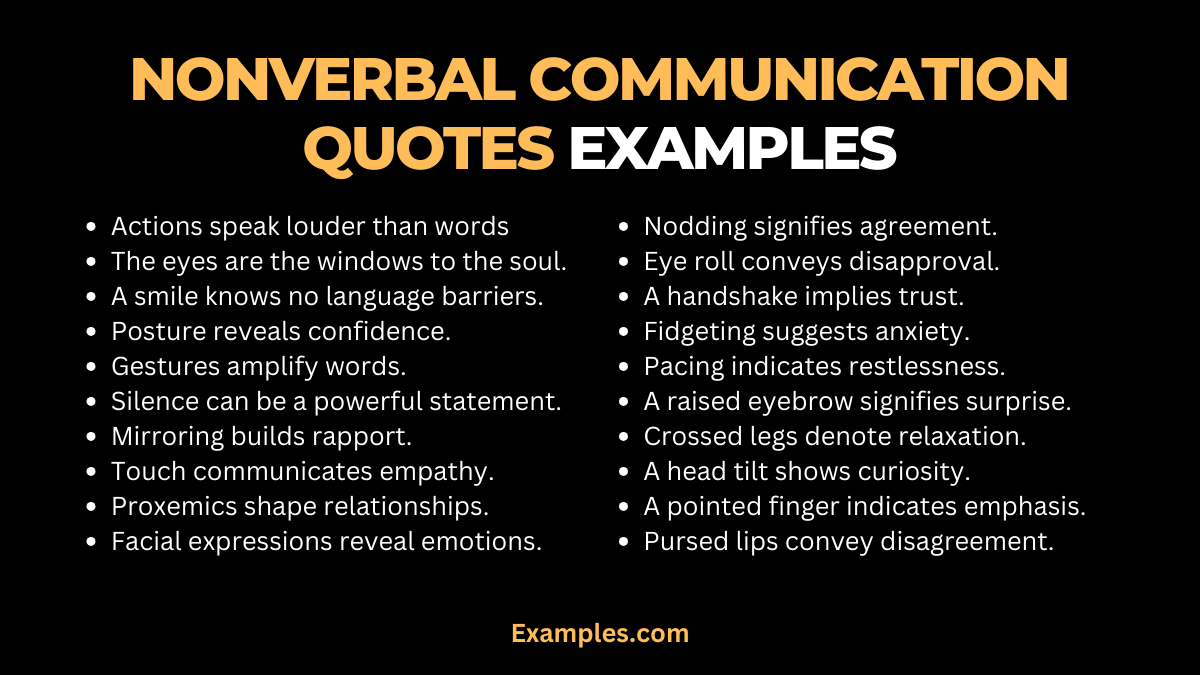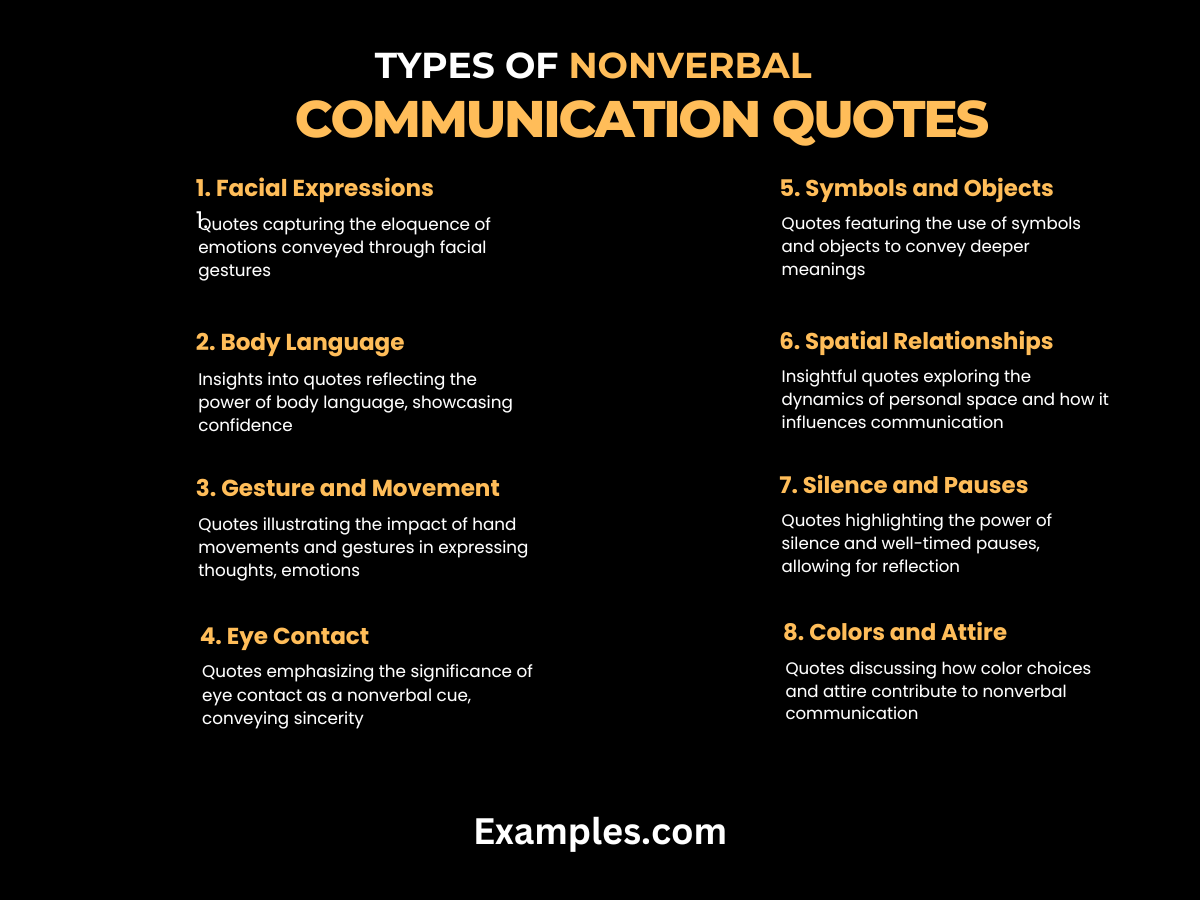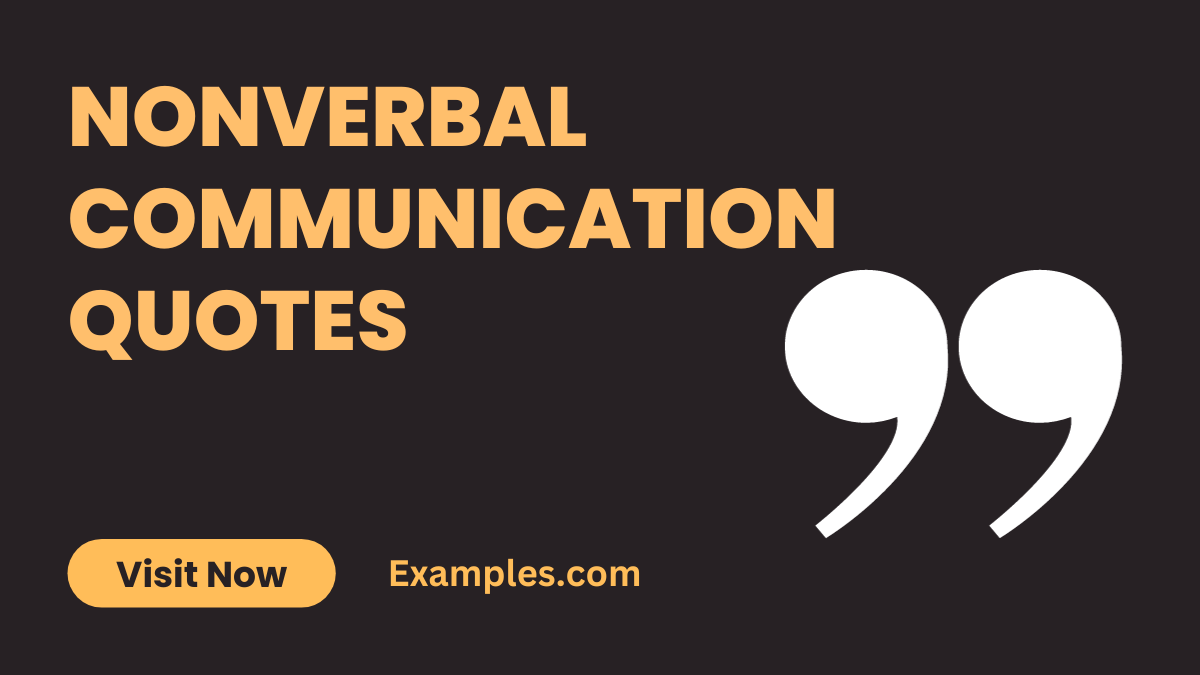29+ Nonverbal Communication Quotes to Download
Delve into the intricate world of Nonverbal Communication Quotes, where words transcend speech. Uncover the silent language through examples that redefine how we perceive and convey messages. This comprehensive guide explores the significance of nonverbal cues, providing insights into their role in effective communication. Witness the art of expression through quotes that speak louder than words, illustrating the nuanced realm of nonverbal communication.
What are Nonverbal Communication Quotes?

Nonverbal Communication Quotes embody the unspoken language of human interaction. In simple terms, these quotes encapsulate the power of gestures, expressions, and body language in conveying messages without relying on verbal communication. They serve as profound reminders that communication extends beyond words, encompassing a rich tapestry of nonverbal elements.
30 Nonverbal Communication Quotes Examples

Unlock the wisdom of Nonverbal Communication Quotes, where silence speaks volumes. Dive into a treasure trove of expressions, each quote a testament to the unspoken language of gestures and body language. Explore these impactful examples that transcend words, offering insights into the profound world of nonverbal communication.
- “Actions speak louder than words.” – In a job interview, a firm handshake communicates confidence and professionalism.
- “The eyes are the windows to the soul.” – Sustained eye contact fosters connection and sincerity in interpersonal relationships.
- “A smile knows no language barriers.” – Smiling at a stranger can convey warmth and friendliness without uttering a word.
- “Posture reveals confidence.” – Standing tall and straight signifies assurance and self-assuredness in any setting.
- “Gestures amplify words.” – A thumbs-up or nod enhances verbal agreement, reinforcing positive communication.
- “Silence can be a powerful statement.” – Pausing before responding can add weight and thoughtfulness to your words.
- “Mirroring builds rapport.” – Subtly imitating gestures fosters a sense of connection and understanding.
- “Touch communicates empathy.” – A comforting touch can convey support and compassion in challenging situations.
- “Proxemics shape relationships.” – Adjusting personal space influences intimacy levels, reflecting comfort or formality.
- “Facial expressions reveal emotions.” – A furrowed brow or a beaming smile instantly communicates feelings without words.
- “Nodding signifies agreement.” – Nonverbal affirmation reinforces verbal consent and understanding in discussions.
- “Eye roll conveys disapproval.” – Rolling eyes subtly communicates disagreement or frustration.
- “Closed body language signals defensiveness.” – Crossed arms and tense posture may indicate discomfort or resistance.
- “Leaning forward expresses engagement.” – Physical proximity indicates active participation and interest in a conversation.
- “A handshake implies trust.” – A firm handshake establishes trust and professionalism in various social contexts.
- “Fidgeting suggests anxiety.” – Tapping fingers or restless movements may reveal nervousness or discomfort.
- “Pacing indicates restlessness.” – Walking back and forth may signify impatience or eagerness to take action.
- “A raised eyebrow signifies surprise.” – Subtle facial cues convey emotions and reactions, enriching verbal communication.
- “Crossed legs denote relaxation.” – Crossed legs in a casual setting showcase comfort and ease.
- “A head tilt shows curiosity.” – Tilting the head while listening indicates interest and attentiveness.
- “A pointed finger indicates emphasis.” – Directing a finger during a discussion highlights a specific point or detail.
- “Rubbing the back of the neck signals stress.” – Nonverbal cues like neck-rubbing may reveal underlying tension.
- “Pursed lips convey disagreement.” – Tightened lips suggest withholding agreement or expressing dissent.
- “A sigh communicates frustration.” – Audible sighs may express impatience or exasperation without verbalizing.
- “Clasped hands signal insecurity.” – Holding hands tightly may indicate discomfort or anxiety.
- “A raised chin signifies confidence.” – Lifting the chin subtly conveys assurance and self-confidence.
- “Averted eyes suggest shyness.” – Avoiding direct eye contact may indicate timidity or reserve.
- “A playful wink conveys flirtation.” – Winking playfully adds a touch of humor and flirtatiousness to interactions.
- “Hair twirling signals nervousness.” – Twirling hair can be an unconscious gesture revealing anxiety or uncertainty.
- “A pat on the back expresses encouragement.” – A friendly pat fosters camaraderie and support in various situations.
Nonverbal Communication Quotes Examples in Literature
Explore the eloquence of nonverbal cues within literary realms. These quotes from literature encapsulate the power of unspoken language, adding depth to characters and narratives. Dive into a world where gestures, expressions, and silence weave intricate tales beyond the written word.
- “His eyes spoke volumes.” – In Hemingway’s “The Old Man and the Sea,” Santiago’s eyes reveal the depth of his struggle and determination.
- “A raised eyebrow hinted at skepticism.” – Austen’s “Pride and Prejudice” uses subtle cues like raised eyebrows to convey character attitudes.
- “The lingering gaze told a forbidden story.” – Brontë’s “Wuthering Heights” employs intense stares to communicate passion and hidden desires.
- “Her clenched fists betrayed hidden turmoil.” – In Morrison’s “Beloved,” Sethe’s clenched fists express repressed emotions and trauma.
- “Silence echoed louder than words.” – In Orwell’s “1984,” moments of silence symbolize rebellion and resistance against oppressive authority.
- “The subtle smirk revealed a hidden agenda.” – In Shakespeare’s “Othello,” Iago’s smirk becomes a nonverbal tool of manipulation and deceit.
- “Averted eyes spoke of inner conflict.” – In Dostoevsky’s “Crime and Punishment,” Raskolnikov’s avoidance of eye contact reflects guilt and inner turmoil.
- “The hesitant handshake portrayed vulnerability.” – Steinbeck’s “Of Mice and Men” uses handshakes to expose characters’ vulnerabilities and trust issues.
- “The turned back symbolized rejection.” – In Hawthorne’s “The Scarlet Letter,” a turned back signifies social ostracism and emotional distance.
- “Their synchronized movements conveyed unity.” – In Tolkien’s “The Fellowship of the Ring,” the characters’ synchronized gestures showcase teamwork and shared goals.
Nonverbal Communication Quotes Examples for Students
Empower students with the language of gestures and expressions. These quotes tailored for students unravel the nuances of nonverbal communication, offering insights into building meaningful connections and navigating academic and social settings.
- “A smile can be your introduction.” – In a group project, a friendly smile creates a positive first impression, fostering collaboration.
- “Eye contact is your silent participation.” – Maintaining eye contact in class signifies engagement and active involvement in the learning process.
- “Confident posture breeds self-assurance.” – Sitting upright during a presentation projects confidence, capturing the audience’s attention and trust.
- “Mirroring builds camaraderie.” – Mirroring a peer’s gestures subtly creates a sense of connection and mutual understanding during group activities.
- “Nonverbal cues during debates convey conviction.” – Gestures and expressions enhance persuasive skills, making a student’s argument more compelling and convincing.
- “Navigating personal space fosters respect.” – Understanding and respecting personal space in social interactions contribute to positive relationships among students.
- “Listening involves more than words.” – Active listening through nonverbal cues, like nodding, shows genuine interest and support during discussions.
- “Reading body language aids in group dynamics.” – Observing classmates’ body language helps students interpret unspoken feelings and opinions during collaborative tasks.
- “Gestures enhance storytelling.” – Using hand gestures while presenting projects adds dynamism, making the information more engaging and memorable.
- “Silence can be a powerful response.” – In classroom discussions, a thoughtful pause before responding allows students to articulate their ideas more effectively.
Nonverbal Communication Quotes Examples at Workplace
Navigate the intricate world of professional interactions with these workplace-centric nonverbal communication quotes. From leadership presence to conflict resolution, these quotes offer valuable insights for effective communication in corporate environments.
- “A firm handshake signifies leadership.” – In a job interview, a strong handshake projects confidence, leaving a positive impression on potential employers.
- “Maintaining eye contact builds trust.” – During business meetings, consistent eye contact fosters trust and credibility in professional relationships.
- “Open body language invites collaboration.” – Encouraging open gestures in team meetings creates an inclusive atmosphere, promoting teamwork and idea sharing.
- “Mirroring in negotiations establishes rapport.” – Subtly mirroring a client’s gestures can create a sense of connection, facilitating smoother negotiation processes.
- “Silence during conflict resolution speaks volumes.” – Allowing a moment of silence after presenting solutions allows team members to reflect before reaching resolutions.
- “Confident posture enhances leadership presence.” – Standing tall in leadership roles communicates authority and inspires confidence among team members.
- “Gestures convey enthusiasm in presentations.” – Using expressive gestures while presenting ideas injects passion and captivates the audience during workplace presentations.
- “Active listening improves team dynamics.” – Demonstrating active listening through nodding and engaged expressions fosters a positive and collaborative work environment.
- “Nonverbal cues in networking events matter.” – Observing and interpreting nonverbal signals at networking events helps professionals navigate social interactions and build connections.
- “Appropriate personal space maintains professionalism.” – Respecting colleagues’ personal space contributes to a comfortable and professional work environment, minimizing potential conflicts.
Types of Nonverbal Communication Quotes

| Type | Description |
|---|---|
| Facial Expressions | Quotes capturing the eloquence of emotions conveyed through facial gestures, adding depth to communication. |
| Body Language | Insights into quotes reflecting the power of body language, showcasing confidence, openness, or tension. |
| Gestures and Movements | Quotes illustrating the impact of hand movements and gestures in expressing thoughts, emotions, or emphasizing points. |
| Eye Contact | Quotes emphasizing the significance of eye contact as a nonverbal cue, conveying sincerity, trust, and engagement. |
| Symbols and Objects | Quotes featuring the use of symbols and objects to convey deeper meanings, enhancing the nonverbal narrative. |
| Spatial Relationships | Insightful quotes exploring the dynamics of personal space and how it influences communication in various contexts. |
| Silence and Pauses | Quotes highlighting the power of silence and well-timed pauses, allowing for reflection and emphasizing certain statements. |
| Colors and Attire | Quotes discussing how color choices and attire contribute to nonverbal communication, influencing perceptions and moods. |
| Mirroring and Synchronization | Quotes on the effectiveness of mirroring and synchronized actions in building rapport and connection between communicators. |
| Nonverbal Rituals | Quotes delving into the significance of repeated actions or rituals as nonverbal cues, establishing patterns in communication. |
How Important are Nonverbal Quotes in Communication?
Nonverbal quotes play a pivotal role in communication, often surpassing the impact of spoken words. They serve as silent messengers, conveying emotions, intentions, and nuances that words may fail to express. The subtleties of facial expressions, body language, and gestures can enhance or contradict verbal messages, influencing how a message is received. Understanding and utilizing nonverbal communication quotes contribute to effective interpersonal connections, improved comprehension, and the establishment of trust. In various scenarios, the nonverbal aspect often becomes the defining factor in the success of communication, emphasizing its indispensable role in conveying the unspoken dimensions of human interaction.
How to Improve Nonverbal Communication Quotes?
Enhance nonverbal communication quotes by refining observation skills, considering cultural nuances, practicing empathy, mastering body language, ensuring contextual relevance, using storytelling techniques, incorporating symbolic imagery, seeking feedback, embracing experimentation, and staying informed about evolving trends. This strategic approach elevates the impact and effectiveness of your nonverbal quotes.
Tips for Effective Nonverbal Communication Quotes
Mastering the art of nonverbal communication quotes involves a strategic understanding of key principles. Follow these tips to craft quotes that eloquently convey emotions, thoughts, and narratives without relying on spoken words.
- Clarity: Ensure nonverbal quotes are clear and unambiguous.
- Consistency: Maintain a consistent emotional tone throughout the narrative.
- Alignment: Align quotes with overarching themes for meaningful contributions.
- Audience Consideration: Tailor quotes to resonate with the audience’s preferences and cultural backgrounds.
- Dynamic Gestures: Integrate dynamic gestures for enhanced emotional impact.
- Expressive Facial Cues: Leverage facial expressions to enrich nonverbal dialogue.
- Pause and Timing: Incorporate well-timed pauses for audience reflection.
- Simplicity and Complexity: Strike a balance suitable for the intended communication depth.
- Narrative Flow: Ensure a seamless transition between emotional states or story elements.
- Authenticity: Infuse genuine emotions into quotes for a profound audience
In conclusion, the exploration of nonverbal communication through quotes offers a rich tapestry of insights into human interaction. These quotes underscore the profound influence of unspoken cues in our daily lives, from the personal to the professional. They remind us that communication extends far beyond the realm of spoken words, tapping into a deeper level of understanding and connection.
To further delve into the nuances of nonverbal communication, readers might find valuable insights in the article “Understanding Body Language and Facial Expressions” from Verywell Mind, which offers a comprehensive look at how nonverbal cues can convey complex emotions and thoughts. Additionally, for those interested in the educational impact of nonverbal communication, the resource “Nonverbal Communication in the Classroom” from Vanderbilt University provides an in-depth analysis of how these silent signals play a crucial role in teaching and learning environments. These resources complement the understanding of nonverbal communication, providing a broader context and practical applications in various settings.



